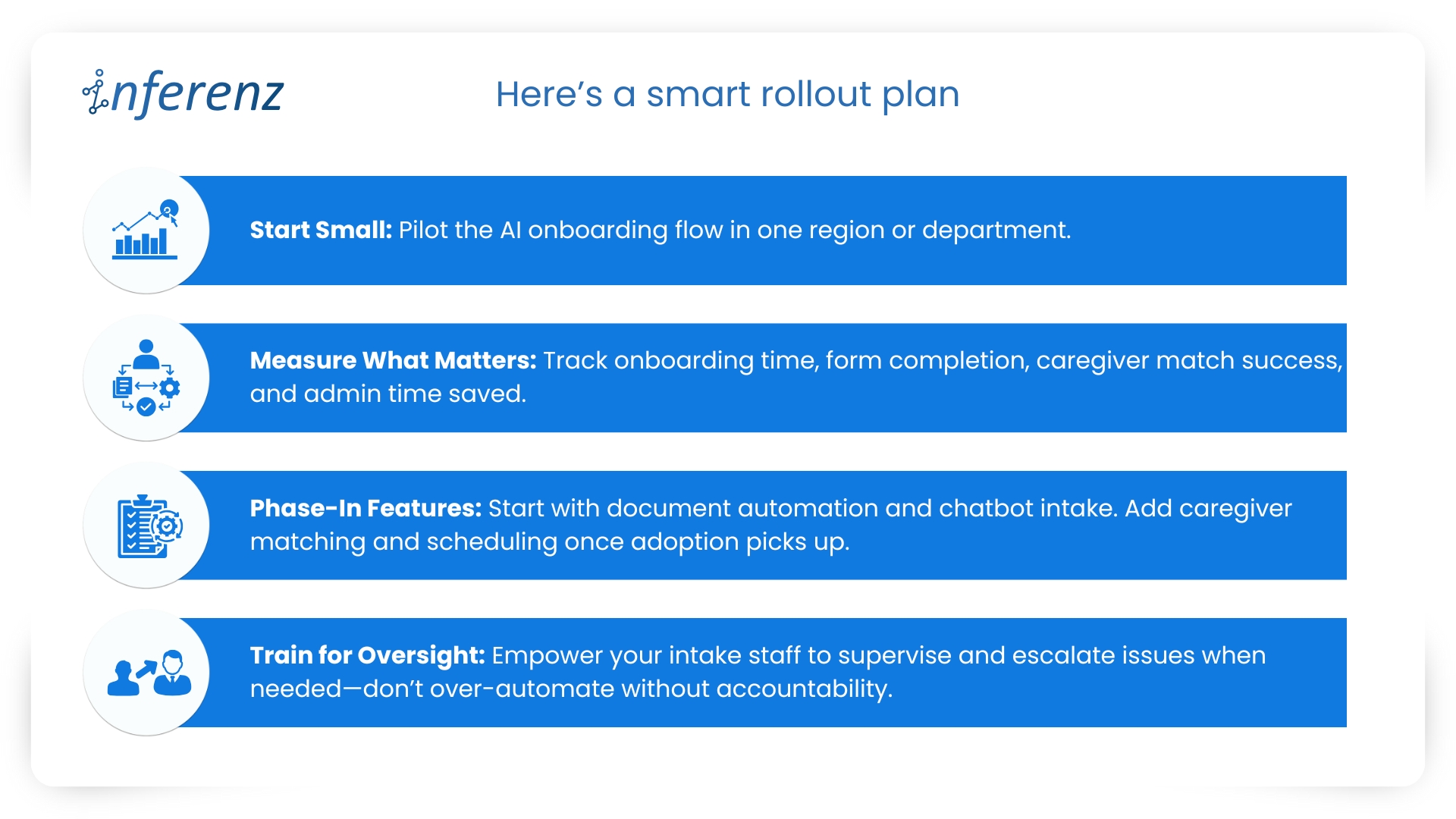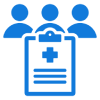Background Summary
AI-powered patient onboarding is reshaping healthcare operations by automating patient intake, reducing manual workload, and improving care quality. This technology empowers homecare providers to streamline processes, enhance patient satisfaction, and deliver cost-effective, personalized care from day one.
First impressions in healthcare shape how patients engage with your team.
Onboarding is often the first real contact a patient has with a homecare provider. At that moment, they fill out forms and seek clarity, support, and direction. The onboarding process though can be slow and confusing.
- Forms are repetitive.
- Follow-ups take time.
- And caregiver assignments don’t always meet patient’s expectations.
These delays impact care delivery. They also drain staff time and slow down billing.
Many healthcare organizations continue to rely on manual intake systems. That means more errors, longer wait times, and lower patient satisfaction scores. It also puts pressure on intake teams, who must chase down missing data or correct mismatches late in the workflow.
AI-powered patient onboarding changes that. It speeds up intake, reduces manual steps, and connects patients with the right caregivers based on skills, location, and availability.
For CXOs leading homecare or healthcare networks, improving the intake process creates measurable gains—in time, cost, and patient outcomes. It’s a decision that improves how the business runs every day.
The State of Patient Onboarding in US Healthcare
Let’s get real: most patient onboarding processes are designed for administrators, not patients.
A recent survey by Accenture found that 36% of patients who switched providers in the past year cited poor onboarding and communication as a key reason. At the same time, the administrative cost of onboarding a new patient can run as high as $200 when factoring in manual data entry, verification, and scheduling time. Multiply that across hundreds or thousands of patients per month, and the financial impact is clear.
Key Stats You Should Know:
- 2–7 days: Average onboarding time for new patients in traditional workflows.
- 75%: Share of patients who expect digital-first intake options (McKinsey).
- $18 billion: Estimated annual cost of redundant admin tasks in US healthcare (CAQH Index).
These numbers aren’t just eye-catching—they’re telling you something. There’s a clear disconnect between what patients expect and what providers are currently offering.
Onboarding, when done right, is not just a compliance formality. It’s a moment of truth. It affects patient retention, caregiver utilization, operational costs, and even Medicare ratings. The good news? Automation and AI can address most of the pain points—without replacing your human staff.
What Today’s Homecare Leaders Expect
Healthcare executives aren’t looking for shiny tech. They’re looking for practical outcomes.
A COO doesn’t want another dashboard. They want their intake team to process 100 new patients a day without burning out. A CIO isn’t chasing buzzwords. They want systems that integrate securely with their EHRs, handle data reliably, and actually reduce workload.
Here’s what’s consistently coming up in boardroom conversations when it comes to patient onboarding:
What CXOs Want from Modern Onboarding:
- Speed without compromising compliance
- A consistent patient experience across multiple touchpoints
- Automated caregiver matching based on real data, not manual guesswork
- Fewer handoffs between systems and departments
- Clear metrics for tracking onboarding performance and satisfaction
One of the recurring frustrations we’ve heard is this: teams spend more time fixing onboarding errors than actually engaging with patients. That’s not scalable. It’s not efficient. And in today’s landscape, it’s not acceptable.
AI-powered automation offers a fix. But only if it solves real operational problems—without becoming another system that needs babysitting.
AI-Powered Onboarding: What It Actually Means
Most leaders agree: onboarding needs to be better. But what does “better” really look like? More importantly, what does AI-powered onboarding actually mean in day-to-day operations?
Let’s break it down without the tech jargon.
At its core, AI-powered onboarding is about speed, precision, and personalization—without burdening your staff or losing regulatory grip. It takes a traditionally manual, fragmented workflow and makes it smarter, connected, and almost invisible to the patient.
So, what does a modern AI-enabled onboarding workflow actually look like?
Imagine a new patient—let’s call her Janet—who’s seeking home health support after a hospital discharge.
Instead of filling out a physical packet or struggling through a clunky portal, she’s greeted by a smart chatbot on her phone. It asks clear, relevant questions. It already knows which forms to show based on her zip code or insurance provider. It even checks that the document photos she uploads (like her insurance card or ID) are valid. The backend? Handled by AI—no need for an admin to sift through every file manually.
In minutes, Janet has completed her intake. She’s matched with a caregiver based on her preferences (language, availability, proximity), and both parties receive a personalized email with the appointment details. It feels seamless.
But under the hood, here’s what’s at play:
Key Components of AI-Powered Patient Onboarding
1. Conversational AI for Intake
- A bot guides the patient using questions that feel human and helpful.
- Questions adapt dynamically based on previous answers.
- It confirms responses in real-time (e.g., “Did you mean 2023 or 2024?”).
- If a patient uploads a document twice without success, the system switches to manual entry instead of creating a bottleneck.
✅ Business Win: Reduces form abandonment, improves data accuracy, and saves staff time.
2. Document Parsing That Actually Works
- Patients can upload a variety of file types: PDFs, photos, even ZIP folders with multiple documents.
- Azure AI extracts key fields like name, DOB, policy number, and address.
- The data is normalized and mapped to the right fields in your system (e.g., Snowflake database).
✅ Business Win: Cuts down 80% of manual data entry, minimizes data errors, and speeds up insurance verification.
3. Custom State Management
- Let’s say Janet drops off midway through onboarding. She gets interrupted.
- No problem. When she returns, the system remembers exactly where she left off.
✅ Business Win: Increases completion rates and reduces patient frustration. Helps your intake metrics look better without any staff intervention.
4. Smart Caregiver Matching
- The system looks at more than just availability.
- It checks caregiver skills, past visit history, languages spoken, and travel distance.
- It computes a weighted score and recommends the best match—not just a random one.
✅ Business Win: Higher match quality means better care, fewer complaints, and improved outcomes. Also helps balance caregiver workload.
5. Scheduling and Notifications
- The system finds the earliest suitable appointment and sends a clear email with the date, time, and contact info.
- If rescheduling is needed, the link is right there in the email.
✅ Business Win: Reduces no-shows, improves transparency, and eliminates back-and-forth calls.
In simpler terms, AI automation doesn’t just speed up onboarding. It improves the quality of the match, the accuracy of the data, and the confidence of the patient walking into their first appointment.
It does what manual teams often struggle with under pressure—at scale and in real time.
Impact on Operational Efficiency: Why CXOs Should Pay Attention
If the previous section showed you the moving parts, this section shows why they matter.
AI-powered onboarding is an operational upgrade that translates into real business value across leadership roles.
For CEOs: Faster Onboarding = Faster Revenue
- The faster a patient is onboarded, the sooner care begins—and the sooner you can bill.
- In many homecare networks, delays of 2–5 days between referral and care initiation are common. AI cuts this down to under 24 hours.
- Improved satisfaction during onboarding often reflects in CAHPS and HCAHPS scores, directly influencing your reputation and Medicare payments.
📊 Stat you can use: Healthcare organizations with high onboarding satisfaction scores report up to 25% higher patient retention over a 12-month period. (Source: NRC Health)
For COOs: Reducing Friction Across Locations
- With AI automation, form templates, workflows, and caregiver matching logic stay consistent—whether your teams are in Chicago, Dallas, or Miami.
- It’s easier to standardize SOPs, train new staff, and maintain service quality.
- Centralized oversight (via admin dashboards) means your regional heads can spot bottlenecks quickly and resolve them before they escalate.
📊 Time saved: A mid-sized home health agency estimated a 60% drop in average onboarding time across its five regions after implementing AI intake.
For CIOs: Secure, Scalable, and Compliant
- The tech stack is built on secure, cloud-native tools like Azure AI, Snowflake, and FastAPI.
- All data handling is HIPAA-compliant, with field-level validations and audit logs.
- System components integrate easily with EHRs or existing CRMs without rewriting everything from scratch.
💡 Why it matters: You don’t need to rebuild your tech landscape. AI onboarding layers in modularly, with low lift on your internal teams.
Metrics That Matter (And That You Can Actually Track)
| Metric | Before AI | After AI | Change |
| Avg. Time to Onboard | 2–3 Days | <10 Minutes | -95% |
| Form Abandonment Rate | 40% | <10% | -75% |
| Manual Entry Errors | High | Minimal | -80% |
| Matched Within SLA | ~60% | 90%+ | +30% |
| Admin Hours Saved | N/A | 4–6 FTEs/month | Cost savings |
AI onboarding helps patients better than before by removing operational drag and unlocking value from day one.
And most importantly, it’s not hypothetical. It’s already working in real organizations across the US

The Tech Stack that Works
Let’s keep it simple. The system works because it combines proven tools in a patient-centric way. Here’s the ecosystem in plain English:
| Component | What It Does | Why It Matters |
| LangChain | Powers the chatbot and forms dynamic questions | Reduces intake friction, adapts in real-time |
| Azure AI | Reads documents like ID cards, insurance | Eliminates manual typing, lowers error rate |
| Snowflake | Stores all validated data securely | Scales fast, works with analytics and dashboards |
| Neo4j | Creates smart caregiver-patient match logic | Improves accuracy and personalization |
| FastAPI | Exposes onboarding & matching results via secure API | Easy to integrate with your other systems |
Security? ✅ HIPAA-compliant
Integration? ✅ Plug-and-play APIs
Scalability? ✅ Built for large volumes without lag
You don’t need a full digital transformation to get started. This plugs into your existing tech quietly and efficiently.
Challenges and What to Watch Out For
No system is perfect out of the box. But the common pitfalls with AI onboarding are manageable with the right approach:
- Training Intake Staff: Even with automation, your team should know how to troubleshoot or step in if a patient gets stuck.
- Patient Trust in Automation: For older adults or less tech-savvy users, the chatbot needs to feel approachable and human.
- Garbage In, Garbage Out: Data validation steps are critical. Weak input logic can ruin caregiver matches.
Pro Tip: Start with a single-region rollout and use metrics like form abandonment, average onboarding time, and caregiver match score to measure success. If the data looks good in 30 days, expand from there.
How to Get Started Without Disrupting Operations
You don’t need to rip out your existing systems to make this work. AI onboarding solutions are designed to slide in—not shake up.
Here’s a smart rollout plan:

💡 Pro Tip: Choose vendors who offer modular deployment, HIPAA-compliance guarantees, and support for EHR integration (like Epic, Cerner).
The Future of Onboarding: What’s Next
AI onboarding is just the beginning. As the healthcare ecosystem evolves, next-gen tools are already taking shape.
Voice-First Intake for Seniors
Scenario: A 78-year-old in assisted living completes onboarding by simply answering a few questions over a voice assistant or phone call—no typing, no touchscreen.
Sourced Statistics: According to CB Insights, over 30% of AI health startups in 2024 are building voice-enabled interfaces for aging populations.
Multilingual Bots for Inclusive Access
Scenario: A caregiver in Florida uses the chatbot in Spanish to complete intake for a new patient. Forms are automatically translated, and backend data remains unified.
Sourced Statistics: McKinsey reports that multilingual tech will be a competitive differentiator for Medicaid and community-based care providers by 2026.
Pre-Onboarding Risk Prediction
Scenario: Before a patient is onboarded, the system flags high hospitalization risk based on intake data. A higher-touch care plan is auto-suggested.
Sourced Statistics: Gartner’s 2025 predictions on predictive AI in healthcare cite onboarding-level data as a new frontier for early intervention.
Seamless Claims Triggering
Scenario: Once a patient is onboarded and matched, billing pre-auth is initiated immediately based on care codes linked to intake data.
Sourced Statistics: HealthEdge’s payer-tech report shows a 35% reduction in claim delays when intake is linked to backend revenue cycle systems.
Closing Note: Don’t Let Your First Touchpoint Be the Weakest Link
Here’s the simple truth: If your onboarding experience still runs on PDFs and follow-up calls, you’re losing patients, revenue, and goodwill—quietly, every day.
AI-powered onboarding isn’t about replacing people. It’s about giving your team room to breathe and your patients a reason to stay. And the best part? It pays for itself in efficiency, satisfaction, and speed to care.
If there’s one place to start your AI journey, it’s not billing. It’s onboarding.
Let your first impression be your strongest one.
FAQs for CXOs Exploring AI-Powered Onboarding
- How long does it take to implement AI onboarding in a mid-sized care facility?
With a modular setup, initial rollout (including chatbot, form automation, and document parsing) can go live in 4–6 weeks. Full caregiver matching and scheduling can follow after pilot testing.
- Will this integrate with our existing EHR or CRM systems?
Yes. The system uses secure RESTful APIs and works well with platforms like Epic, Cerner, Salesforce Health Cloud, or even custom-built portals. Integration typically requires limited IT involvement.
- What’s the ROI we can expect within the first quarter?
Typical early benefits include a 60–80% drop in onboarding time, 75% reduction in admin errors, and a 20–25% increase in form completion rates—leading to faster care starts and fewer dropouts.
- How do we ensure patient data security and HIPAA compliance?
The entire architecture is designed with encryption, audit logging, access control, and HIPAA compliance baked in. Azure and Snowflake components adhere to top-tier security standards.
- What if our patients aren’t tech-savvy?
The system uses an intuitive chatbot interface with fallback options like voice-based intake or manual intervention. For seniors or non-digital users, guided support workflows ensure inclusivity.
- Can we customize caregiver matching rules to fit our network’s protocols?
Absolutely. The recommendation engine allows you to prioritize attributes such as languages, visit history, location radius, or skills based on your care guidelines.













